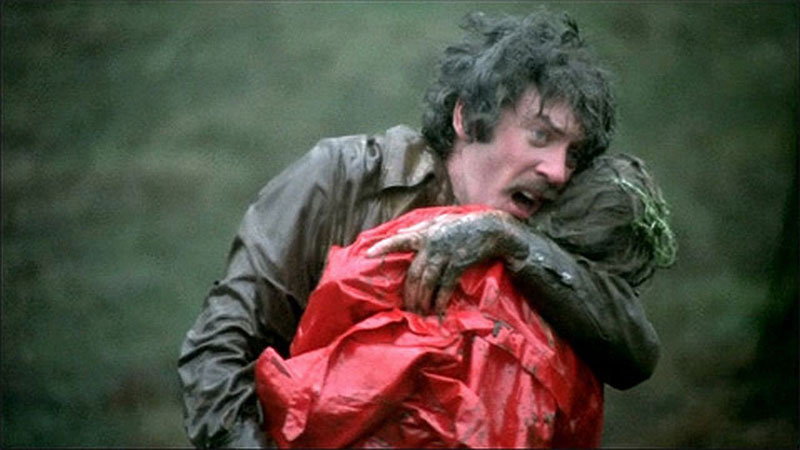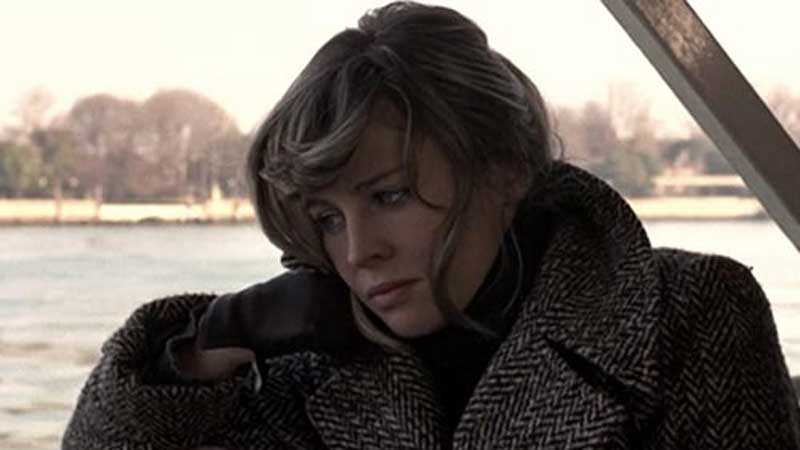DON’T LOOK NOW 1973: In an exclusive extract from Horror Pickers, HOWARD JACKSON reviews the thriller classic starring Donald Sutherland and Julie Christie…

TITLE: Don’t Look Now
RELEASED: 1972
DIRECTOR: Nicolas Roeg
CAST: Julie Christie, Donald Sutherland
Before anything else is said we need to talk about sex. The rumour is false. Donald Sutherland and Julie Christie did not copulate on the set of Don’t Look Now and in front of the cameraman. They were acting or pretending if you like.
The director Nicolas Roeg filmed the scene before he began work on the rest of the film. Roeg filmed it early so that the actors and technicians could work later without worrying about whether they would be embarrassed.
Watching the sex between John and Laura Baxter, the couple played by Sutherland and Christie, the audience suspects that this is the first time that John and Laura have had physical intimacy since their child drowned in the pond outside their home in England. We suspect because, although the copulation is explicit, the significance behind the scene is not.
The meaning of the scene is lost not just in obscurity but also in the emphasis on glamour and fashion fetishism. The scene, though, like the film, is memorable and iconic. Don’t Look Now is a movie that has plenty of style.
Before being a director, Nicolas Roeg was a cinematographer. His work was impressive on the sixties version of Far From The Madding Crowd. Anyone who wants to know why Thomas Hardy abandoned novels for poetry only needs to read the title of his famous novel about the headstrong Bathsheba. Both Roeg and Hardy were convinced that meaning could be defined by style.
The novels of Hardy and the films of Roeg depend on the impact of random coincidences. Some people call it melodrama. Julie Christie played Bathsheba in Far From The Madding Crowd. In Don’t Look Now, Christie plays a mother grieving about a lost daughter. Laura Baxter appears to be dependent on her successful husband. He is a man who makes a lot of money restoring cathedrals. The pond outside his home is more like a small lake.
The film Don’t Look Now is based on a short story by Daphne du Maurier. She wrote a Jane Eyre rip off called Rebecca. Despite limited talent and a sloppy style she was popular. Movie adaptations made her rich. In Don’t Look Now there is a blind psychic, complete with duff contact lenses, who tells Laura that she can see the dead daughter sitting between the couple.
Later the blind psychic warns Laura that her husband John is in danger in Venice and should leave. While John and Laura are in Venice their son is in boarding school. The son has an accident, and Laura returns to England. John, though, who is still in Venice, is convinced that he sees Laura and the blind psychic on a canal boat. There are a couple of other unsettling incidents and, at the end of the film, a murder.
Don’t Look Now relates to the horror genre in the same way as The Usual Suspects does to crime movies. The odd incidents that occur throughout the film are connected in a surprise ending. In The Usual Suspects the coincidences are linked by a creative liar. The joke is on the audience, and the pleasure is in knowing that you have been had by someone who is unscrupulous and happy to be amused by his deceits. Don’t Look Now is much more serious and at times it is weighed down with pretension. Too often it feels like something made by groomed designers pretending to be intellectuals.
The skills of the technical, though, are important. The set pieces in Don’t Look Now are impressive. The initial accident connects the drowning of the daughter to a ruined slide. This and the later collapse of the scaffold in the Cathedral require daring and confidence by the director, photographer and editor. Sutherland appears to risk his life on the scaffold; either that or the choice of stand-in is excellent.
At the beginning of the film at the impressive home in Hertfordshire Julie Christie sits by a coal fire and reads a book called Beyond The Fragile Geometry Of Space. The coincidences in Don’t Look Now are not the product of a fertile mind making connections. These coincidences are mysterious and they are meant to have significance. There is something that surrounds us that we miss or cannot see.
All we see is what we think is happening now. The rest, the metaphysical infrastructure, is missed, hence the title of the film. To see everything around us and ‘beyond the fragile geometry of space’ we have to recognise what belongs to the past and the future. Sutherland looks like someone making the effort.
He is convincing as a man who is carrying his own fate. There is much in the film that confuses curious John Baxter. He sees complicated streets, hears odd telephone calls, meets bizarre people and witnesses incidents that not only evoke the past but also promise to link the past to the future. Venice has history and is a city of shadows. The echo of his footsteps is a burden that inspires dread.

To ensure that the audience acknowledges the complexity and mystery of what it witnesses Roeg adds the inexplicable to cause confusion and uses complex and brilliant editing. In one scene we see the psychic and her sister laughing at a family photograph. The reason for their amusement is not explained. The Italian dialogue is not subtitled, and there is a telephone conversation where the absence of subtitles gives the non-Italian speaking viewers a false impression of what is happening.
In another we hear a priest talk to a woman. His conversation could be about anything. These odd moments do add to the mystery and they are consistent with themes that exist within the film, our inability to communicate and understand each other and events. But they also patronise Italians, and that attitude is an unattractive aspect of the film. The woes of the beautiful English middle class couple are given respect. All the other people in the movie are inferior eccentrics. For all the emphasis on coincidence Roeg misses the biggest one of all.
The final murder is a triumph of failure and neglect over talent and inheritance. The triumph is short-lived. The enigmatic smile at the funeral is a reminder that the superior will prevail and remain supreme.
The idea that we carry around our own fate, and that it is there in the darkness and the cracks between the ‘fragile geometry’, is not original. The style of the film creates a mystery but the revelation is not that much of a surprise. The ending is interesting, though, because it explains and justifies the narrative technique. Doom begins a long way back and the doomed, who may be all of us, spend their lives blind to its inexorable progress.
Both John and Laura Baxter are attempting to restore the past and redefine the present. Laura wants the psychic medium to introduce someone from the past into the present, her dead daughter. John heads the team that is recreating how the Venetian Cathedral looked before present day decay. Laura wants to speak to a dead child. John wants to hide how the Cathedral really looks and perhaps should if it is to be authentic.
John spends a lot of the film looking at something. Compared to the rest of us in the audience he is a superior observer. John also has a repressed psychic gift. His fate will not only combine the past and the present but the coincidences created by others that link the past to the present. If the second clause of that sentence makes the theme sound like mumbo jumbo, it is probably because it is. Adding the priest in the film to the mystery overeggs what was a half decent theory.
Much has been said about the motifs that dominate the film. These are water, the use of the colour red and the broken glass. The motifs do exist. The use of water links sex to death, something of us dies when we have sex, and we have sex with people who will eventually become rotting corpses. The colour red highlights the spilt blood that accompanies violent death and it also ensures that the accident to the lost daughter will not be forgotten.
The broken glass confirms that what we see is fragile. We break the reflections of what we see and do not understand. If anything, though, the motifs are over-used. The complex editing suits the purpose of the film but that and the repeated motifs make the meaning of the film less significant. Too much is fractured for themes to be developed and explored. Instead we have contrived coincidences that a clever director, rather than mystery and fate, insists we have to connect.
The music of Don’t Look Now has its fans but to me it often sounds misplaced. Romantic themes substitute for mystery, and frenetic rococo is used rather than more suitable moody gothic. Pino Donaggio wrote the musical score. He also wrote You Don’t Have To Say You Love Me, which was recorded by Dusty Springfield and Elvis Presley. There is a connection.
Like John and Laura Baxter both Dusty and Elvis were gifted and troubled. Burdened with careers that could only be sustained by talent and youth they were soon obliged to carry their own fates. No doubt that once their fates became apparent they would have been obliged to walk on broken glass and see not just reflections but warnings of destruction.
You can order Horror Pickers from Amazon or Red Rattle Books.
Tell us what you thought of Don’t Look Now 1973 in the comments section!

